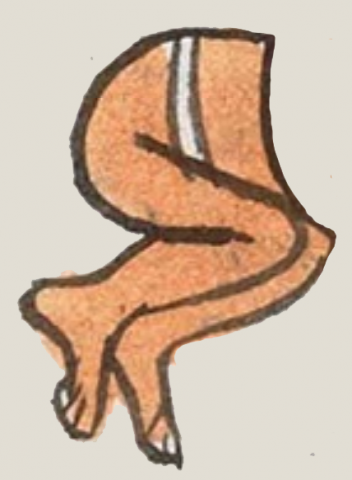tzintli (Mdz40r)
This element was carved from the compound glyph for the place name Cuauhtecomatzinco. In this representation of tzintli, a phonetic indicator for the reverential suffix (-tzin) and not literally meant to refer to the man's buttocks, we see about half a human body, somewhat horizontal, pointed toward the viewer's right, largely naked. We know it is male because we see the white waistband of the loincloth. The knees are up against the abdomen, making the bottom more prominent, but not particularly detailed, being in profile. On the other hand, there is a fair amount of detail in the legs and feet, showing some toes and a couple of white toenails. Other than the white belt and toenails, the body is painted a tan-flesh color.
Stephanie Wood
As with all—or at least the vast majority—of examples of this glyph, the meaning "buttocks" has nothing to do with the meaning of the glyphs, although it may have a metaphorical value of "lower." When modifying a place name, as Frances Karttunen suggests, the meaning of "tzin" is new, little, or lower. It can also refer to something revered, for instance, when combined with something having the element "teo" (from teotl, divine force).
Stephanie Wood
c. 1541, or by 1553 at the latest
Stephanie Wood
David Elliott made the SVG.
butts, buttocks, rear end, little, lower, bottom, nalgas, trasero

tzin(tli), buttocks, https://nahuatl.wired-humanities.org/content/tzintli
-tzin, new, little, lower, or reverential, https://nahuatl.wired-humanities.org/content/tzin
buttocks, bottom, anus; little, lower
las nalgas, el ano
Stephanie Wood
Codex Mendoza folio 40 recto, https://digital.bodleian.ox.ac.uk/objects/2fea788e-2aa2-4f08-b6d9-648c00..., image 90 of 188.
The Bodleian Libraries, University of Oxford, hold the original manuscript, the MS. Arch. Selden. A. 1. This image is published here under the UK Creative Commons, “Attribution-NonCommercial-ShareAlike 3.0 License” (CC-BY-NC-SA 3.0).


